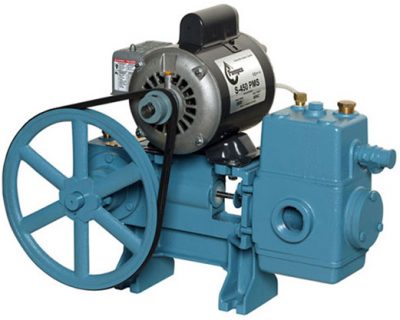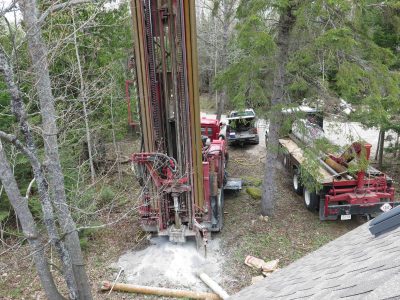Your first task is to learn to recognize what kind of water well you have, and to recognize the type of wells other people you need to help might have. As with any technical endeavor, you need to start with an understanding of the basics before anything else.What You Need to Know About Water Pumps
There are three main kinds of water well pumps in the world: submersible pumps; jet pumps; and piston pumps. Of these three, the piston pump is the most rare. As time goes on you see fewer and fewer of them.
 Piston Pumps: You can tell a piston pump by the quiet, pleasant “thumpa-thumpa” sound they make as they operate. Most also include a couple of visible rubber drive belts connected to an electric motor by exposed metal pulleys. Piston pumps are great for shallow well situations with up to 300 feet of horizontal draw, but never for raising water more than about 20 vertical feet. Piston pumps used to be very popular decades ago, but are falling out of favor because of their high cost relative to pump output. Remember this “20 vertical feet” business. It’s quite crucial, as you’ll see later. If you’ve got a working piston pump at your place, by all means keep using it. If you need to buy a new pump, a piston pump isn’t your best choice. You’re better off with a jet pump or a submersible as I’ll explain.
Piston Pumps: You can tell a piston pump by the quiet, pleasant “thumpa-thumpa” sound they make as they operate. Most also include a couple of visible rubber drive belts connected to an electric motor by exposed metal pulleys. Piston pumps are great for shallow well situations with up to 300 feet of horizontal draw, but never for raising water more than about 20 vertical feet. Piston pumps used to be very popular decades ago, but are falling out of favor because of their high cost relative to pump output. Remember this “20 vertical feet” business. It’s quite crucial, as you’ll see later. If you’ve got a working piston pump at your place, by all means keep using it. If you need to buy a new pump, a piston pump isn’t your best choice. You’re better off with a jet pump or a submersible as I’ll explain.
Watertight Connections
 Black polyethylene water pipe is the mainstay of intake lines and rural water distribution systems in most regions, and screw clamps tightened onto barbed metal connection fittings are the way joints are made leak-proof. Trouble is, screw clamps alone won’t make reliable connections on black poly pipe. You also need to heat and soften the pipe with a propane torch or heat gun before tightening the screw clamps down. If you don’t heat you probably won’t get a tight seal. You know you’ve heated the pipe enough when it becomes noticeably softer and more pliable. A sufficiently heated pipe also takes on something of a shiny sheen on the outside when it’s hot enough. Have the loose screw clamps sitting on the pipe and ready to go before you heat, then bring the connection together quickly, slide the clamps into position, then tighten them with a small socket wrench. Just to be safe, use two clamps per joint, spending the little extra money for stainless steel clamps. Always use a socket wrench or nut driver to tighten the hex head on a screw clamp. A screwdriver alone only develops marginal torque for this job.
Black polyethylene water pipe is the mainstay of intake lines and rural water distribution systems in most regions, and screw clamps tightened onto barbed metal connection fittings are the way joints are made leak-proof. Trouble is, screw clamps alone won’t make reliable connections on black poly pipe. You also need to heat and soften the pipe with a propane torch or heat gun before tightening the screw clamps down. If you don’t heat you probably won’t get a tight seal. You know you’ve heated the pipe enough when it becomes noticeably softer and more pliable. A sufficiently heated pipe also takes on something of a shiny sheen on the outside when it’s hot enough. Have the loose screw clamps sitting on the pipe and ready to go before you heat, then bring the connection together quickly, slide the clamps into position, then tighten them with a small socket wrench. Just to be safe, use two clamps per joint, spending the little extra money for stainless steel clamps. Always use a socket wrench or nut driver to tighten the hex head on a screw clamp. A screwdriver alone only develops marginal torque for this job.
 Jet Pumps: These are a popular choice because they’re the least expensive water well pump going and they can work in both shallow or deep-well modes. You can tell you’ve got a jet pump because it sits above ground, and it makes a kind of whooshing sound as it operates. Jet pumps need to be “primed” before they’ll work. This means the entire pump casing and intakes lines are completely filled with water. Even a small amount of air in the lines stops jet pumps from pumping. Jet pumps may be common and cheap, but they’re not my favourite type. Submersible pumps are much better in my book, as you’ll see.
Jet Pumps: These are a popular choice because they’re the least expensive water well pump going and they can work in both shallow or deep-well modes. You can tell you’ve got a jet pump because it sits above ground, and it makes a kind of whooshing sound as it operates. Jet pumps need to be “primed” before they’ll work. This means the entire pump casing and intakes lines are completely filled with water. Even a small amount of air in the lines stops jet pumps from pumping. Jet pumps may be common and cheap, but they’re not my favourite type. Submersible pumps are much better in my book, as you’ll see.
 Submersible Pump: These aren’t as cheap as jet pumps for a given size, but they’re more than worth the extra money for several reasons. They move more water than other pumps of a given horsepower and they never need priming. That’s because the pump itself sits below water level in the well – wires and all. You know you’ve got a submersible pump because there’s no pump to be seen anywhere. Water simply flows into your home from a pipe noiselessly. All submersible pumps need to be supplied with electricity, so wires or a conduit leaving your home and making its way down the well is another telltale sign you’ve got a submersible. Pumps like these also play a crucial role in getting lots of water from a weak well, as I’ll show you later.
Submersible Pump: These aren’t as cheap as jet pumps for a given size, but they’re more than worth the extra money for several reasons. They move more water than other pumps of a given horsepower and they never need priming. That’s because the pump itself sits below water level in the well – wires and all. You know you’ve got a submersible pump because there’s no pump to be seen anywhere. Water simply flows into your home from a pipe noiselessly. All submersible pumps need to be supplied with electricity, so wires or a conduit leaving your home and making its way down the well is another telltale sign you’ve got a submersible. Pumps like these also play a crucial role in getting lots of water from a weak well, as I’ll show you later.
How Water Well Systems Work
There are three main parts to any water well system that delivers flowing water: the pump, the pressure tank, and the pressure switch. All types of water pumps have some version of these parts. The pressure switch monitors pressure in the pressure tank, turning the pump ON when tank pressure falls below some preset level. This is typically 30 psi to 40 psi. The pressure switch recognizes a rise in tank pressure as the pump delivers more water to the tank, then turns the pump OFF when this preset high level is hit. This is typically 50 psi to 60 psi. This rising and falling of tank pressure is common to almost every private water well system. Common, but not desirable nor inevitable. Later in the ebook I’ll show you how to have very constant water pressure from a pump-driven system. Besides better performance, your pump will also last longer this way.
Water Questions to Ask When Choosing a Rural Property
 If you’re looking for a rural property to settle on, questions about groundwater are one of the most important things you can ask. It’s easy for less than honest people to hide issues like insufficient, bad tasting or contaminated water in the area. Asking additional questions beyond a real estate agent or the property owner may be the most important water-related skills you’ll exercise. Finding a property with safe, tasty and abundant groundwater is more than half the battle. Ask questions like:
If you’re looking for a rural property to settle on, questions about groundwater are one of the most important things you can ask. It’s easy for less than honest people to hide issues like insufficient, bad tasting or contaminated water in the area. Asking additional questions beyond a real estate agent or the property owner may be the most important water-related skills you’ll exercise. Finding a property with safe, tasty and abundant groundwater is more than half the battle. Ask questions like:
- How deep do wells have to go to find abundant water in this area?
- Is there sulphur water, natural gas, a nearby landfill or other local geological issues that might cause problems with water quality?
- If you’re looking at buying a property with an existing well, how deep is the well? What kind of well? How far from the surface is the water? How much reserve water does the well actually hold? You’ll learn more about all these questions as you go through this course.

The specifics of water wells comes down to the type of pump used and the depth of water from the surface. The illustrations and video coming up shows how parts of water well systems are connected, including a foot valve, check valve, pump, pipes, fittings, pressure tank, pressure switch and other parts.